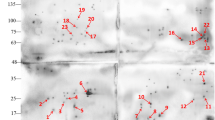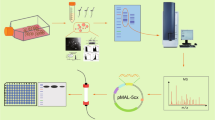Abstract
In the poultry industry, Eimeria spp. is one of the important pathogens which cause significant economic losses. We have previously generated a chicken monoclonal antibody (mAb), 6D-12-G10, with specificity for an antigen located in the apical cytoskeleton of Eimeria acervulina and with cross-reactive among Apicomplexan parasites, including other Eimeria spp., Toxoplasma, Neospora, and Cryptosporidium spp. Furthermore, the protein of Cryptosporidium parvum recognized by the 6D-12-G10 has been identified as elongation factor-1α (EF-1α). In the present study, to identify the target molecule of E. acervulina by the mAb, we performed two-dimensional Western blotting analysis. Finally, we found two positive molecules which are identified as EF-1α and a related protein. Our previous finding using C. parvum and the results in this study suggest that EF-1α could be associated with the invasion facilitated by the cytoskeleton at the apical region of zoites.



Similar content being viewed by others
References
Becker M, Kuhse J, Kirsch J (2013) Effects of two elongation factor 1A isoforms on the formation of gephyrin clusters at inhibitory synapses in hippocampal neurons. Histochem Cell Biol 140:603–609
Blackman MJ, Bannister LH (2001) Apical organelles of Apicomplexa: biology and isolation by subcellular fractionation. Mol Biochem Parasitol 117:11–25
Choi WI, Kim Y, Kim Y, Yu MY, Park J, Lee CE, Jeon BN, Koh DI, Hur MW (2009) Eukaryotic translation initiator protein 1A isoform, CCS-3, enhances the transcriptional repression of p21CIP1 by proto-oncogene FBI-1 (Pokemon/ZBTB7A). Cell Physiol Biochem 23:359–370
Constantinoiu CC, Lillehoj HS, Matsubayashi M, Hosoda Y, Tani H, Matsuda H, Sasai K, Baba E (2003) Analysis of cross-reactivity of five new chicken monoclonal antibodies which recognize the apical complex of Eimeria using confocal laser immunofluorescence assay. Vet Parasitol 118:29–35
Dalloul RA, Lillehoj HS (2006) Poultry coccidiosis: recent advancements in control measures and vaccine development. Expert Rev Vaccines 5:143–163
Doyle A, Crosby SR, Burton DR, Lilley F, Murphy MF (2011) Actin bundling and polymerisation properties of eukaryotic elongation factor 1 alpha (eEF1A), histone H2A-H2B and lysozyme in vitro. J Struct Biol 176:370–378
Dubremetz JF, Garcia-Réguet N, Conseil V, Fourmaux MN (1998) Apical organelles and host-cell invasion by Apicomplexa. Int J Parasitol 28:1007–1013
Hatefi Y, Yamaguchi M (1996) Nicotinamide nucleotide transhydrogenase: a model for utilization of substrate binding energy for proton translocation. FASEB J 10:444–452
Hu K, Roos DS, Murray JM (2002) A novel polymer of tubulin forms the conoid of Toxoplasma gondii. J Cell Biol 156:1039–1050
Laemmli UK (1970) Cleavage of structural proteins during the assembly of the head of bacteriophage T4. Nature 227:680–685
Lillehoj HS, Sasai K, Matsuda H (1994) Development and characterization of chicken-chicken B cell hybridomas secreting monoclonal antibodies that detect sporozoite and merozoite antigens of Eimeria. Poult Sci 73:1685–1693
Matsubayashi M, Kimata I, Iseki M, Lillehoj HS, Matsuda H, Nakanishi T, Tani H, Sasai K, Baba E (2005) Cross-reactivities with Cryptosporidium spp. by chicken monoclonal antibodies that recognize avian Eimeria spp. Vet Parasitol 128:47–57
Matsubayashi M, Takase H, Kimata I, Nakagawa H, Tani H, Sasai K, Baba E (2008) Electron microscopic observation of cytoskeletal frame structures and detection of tubulin on the apical region of Cryptosporidium parvum sporozoites. Parasitology 135:295–301
Matsubayashi M, Teramoto-Kimata I, Uni S, Lillehoj HS, Matsuda H, Furuya M, Tani H, Sasai K (2013) Elongation factor-1α is a novel protein associated with host cell invasion and a potential protective antigen of Cryptosporidium parvum. J Biol Chem 288:34111–34120
Morrissette NS, Sibley LD (2002) Cytoskeleton of apicomplexan parasites. Microbiol Mol Biol Rev 66:21–38
Ransom-Hodgkins WD (2009) The application of expression analysis in elucidating the eukaryotic elongation factor one alpha gene family in Arabidopsis thaliana. Mol Genet Genomics 281:391–405
Ridgley EL, Xiong ZH, Kaur KJ, Ruben L (1996) Genomic organization and expression of elongation factor-1 alpha genes in Trypanosoma brucei. Mol Biochem Parasitol 79:119–123
Riis B, Rattan SI, Clark BF, Merrick WC (1990) Eukaryotic protein elongation factors. Trends Biochem Sci 15:420–424
Sasai K, Lillehoj HS, Hemphill A, Matsuda H, Hanioka Y, Fukata T, Baba E, Arakawa A (1998) A chicken anti-conoid monoclonal antibody identifies a common epitope which is present on motile stages of Eimeria, Neospora, and Toxoplasma. J Parasitol 84:654–656
Sasai K, Lillehoj HS, Matsuda H, Wergin WP (1996) Characterization of a chicken monoclonal antibody that recognizes the apical complex of Eimeria acervulina sporozoites and partially inhibits sporozoite invasion of CD8+ T lymphocytes in vitro. J Parasitol 82:82–87
Santos JM, Lebrun M, Daher W, Soldati D, Dubremetz JF (2009) Apicomplexan cytoskeleton and motors: key regulators in morphogenesis, cell division, transport and motility. Int J Parasitol 39:153–162
Schmatz DM, Crane MS, Murray PK (1984) Purification of Eimeria sporozoites by DE-52 anion exchange chromatography. J Protozool 31:181–183
Stotish RL, Simashkevich PM, Wang CC (1977) Separation of sporozoites, sporocysts, and oocysts of Eimeria tenella by centrifugal elutriation. J Parasitol 63:1124–1126
Vermeulen AN, Kok JJ, van den Boogaart P, Dijkema R, Claessens JA (1993) Eimeria refractile body proteins contain two potentially functional characteristics: transhydrogenase and carbohydrate transport. FEMS Microbiol Lett 110:223–229
Yang F, Demma M, Warren V, Dharmawardhane S, Condeelis J (1990) Identification of an actin-binding protein from Dictyostelium as elongation factor 1a. Nature 347:494–496
Acknowledgments
We are grateful to Dr. Y. Fukuta, from the APRO Life Science Institute, Inc., for the LC-MS/MS analyses. This study was supported in part by the Grants-in-aid for Scientific Research 23580445 (to K. S., H. T., M. F., and M. M.) and 25450436 (to M. M.) from the Ministry of Education, Culture, Sports, and Science.
Author information
Authors and Affiliations
Corresponding author
Ethics declarations
Ethics statement
Any animals were not scarified for the purpose of this study. Any human participants were not involved in this study. All the authors have no conflict of interest.
Rights and permissions
About this article
Cite this article
Matsubayashi, M., Minoura, C., Kimura, S. et al. Identification of Eimeria acervulina conoid antigen using chicken monoclonal antibody. Parasitol Res 115, 4123–4128 (2016). https://doi.org/10.1007/s00436-016-5185-0
Received:
Accepted:
Published:
Issue Date:
DOI: https://doi.org/10.1007/s00436-016-5185-0




